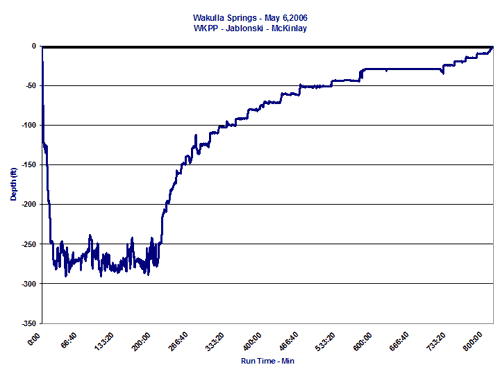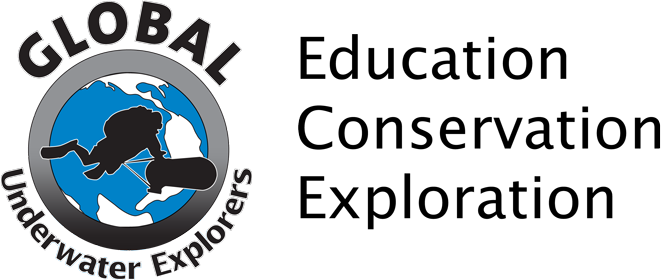WKPP Update - May 5-6
WKPP Update - May 5-6
Update by Casey McKinlay
After six long years of work focusing almost exclusively on scientific inquiry the time had come to return to the other pivotal work done by the WKPP; with some clear water we were ready to resume exploration of Wakulla Springs. Capitalizing on the success of our April 23 outing, we needed to get additional safety cylinders into the system and move the existing 6,500 cylinders out to at least 11,000 feet. We would go with three teams this time out and re-establish the setup routines from 2000, but with some more aggressive planning in terms of distance, given the speed of the April 23 dives and the fact that all long-range setup teams would be using RB80s. In 2000, we leveraged short-mid-range open-circuit teams to deliver scooters and cylinders to 4,800 feet; a single RB setup team to move gear to 8,000 feet; and a primary exploration team to take it from there. This time out, we would attempt to move as much gear as possible to the 11,000-foot depot. This would allow the exploration team to move quickly through the first 2 miles of cave before picking up numerous scooters and cylinders. La Nina was weakening, rain was in the forecast, and hurricane season was fast approaching. There would be limited opportunities to explore and hopefully establish a connection to the theoretical North-South Leon Sinks conduit heading toward Spring Creek and the Gulf of Mexico. The dives would be big and potentially record-breaking in terms of distance and depth. The record was a non-issue from my point of view, because I wanted the connection or proof of a physical connection in addition to the dye-trace confirmation. The long-term goal of the WKPP, in addition to research support and education, is to physically connect these cave systems and answer fifty-plus years of speculation. I prefer to let others worry about the records as we pursue the primary mission of the WKPP.
Before we could hit the water, there were a few housekeeping items that needed to be addressed in the Wakulla basin. The recent rains had turned the basin slightly green from crystal-blue only two weeks earlier. Visibility was still 100-plus feet when the support teams hit the water on Friday to position the decompression gas for eight RB80 divers and extract the west habitat and 120-foot trough. The floor needed to be replaced in the west habitat. We considered a patch to support the broken beam, but given the amount of diving scheduled, we decided to replace the entire floor and support beams. The floor had lasted more than eight years, and we decided to add some more support beams and go with thicker plywood this time. We did not want to have to extract the habitat again for at least ten years. Bob Sherwood, Doug Mudry, Gideon Liew and Alexander Sawyer made quick work of the extraction and had the habitat up on the beach within an hour. We moved the habitat up to the parking area and stripped it down. Over the next two hours we replaced the beams, flooring and carpet, and had it back down on the beach for delivery. Huge thanks to Mark Messersmith for toughing it out inside the habitat and getting the job done. Lastly, the 120-foot steel trough had finally reached a point where it needed to be retired and replaced with a plastic poly trough. The setup team had the old trough out and the new trough in place in no time. I expect some good video of both replacements, as Bob was on the camera for most of the afternoon basin work. With the housekeeping complete, the support guys switched to tank placement and positioned sixty cylinders for the Saturday teams. Thanks to Scott Cox and Kell Canty for gearing up and jumping in so we could meet the 7:40 pm dinner reservation in the dining room. A team dinner in the lodge and early to bed was next on the schedule. Saturday would be a long day Rebreather Plan:
- Team 2 – deliver three safeties to 4,800 feet and deliver six additional safeties between 4,800 and 6,500 feet
- Team 3 – move six safeties from Team 2 out to 6,500 feet and deliver six drive bottles to be used on the April 20 exploration dive
- Team 1 – move nine safeties from 6,500 to 11,000 feet
- Team 1 – cleanup line and re-mark T’s between 6,500 and 11,000 feet
Another early start was in order. To make the most of the day and eliminate the need for late-night support, we decided to move the schedule up as early as possible. Using Friday for basin setup and equipment prep was a huge advantage to getting things off and running early on Saturday. With Shellie out, it would be Hunter running the surface along with a capable support crew and support from some of the park staff. Once again, we had David Rhea scheduled to shoot photos while decompressing, Anthony Rue on the second camera and Miami Herald reporter Sue Cocking in the water with escort for a first-hand look at decompression support. Sue has been covering the project for years, so it was great to have her back as we kicked things off. Video coverage in the basin would be handled by Derek Bennett, Scott Cox, Chris Werner and Bob Sherwood. It was great to see the deep video guys in position as we hit the entrance restriction at 170 feet. RB80 Team 1
(Jablonski, McKinlay) Our plan would not require a setup team, so the earlier the start, the better. Planned bottom time would be 200 minutes at 250 – 275 feet, depending on visibility in the cave. We departed the Wakulla beach around 8 a.m. with two drive bottles and two scooters in tow. We passed the deep video team and motored into the Grand Canyon room for the switch to 300 gas. We completed the switch, and I fired up the Mini-Mee video unit and lighting. This would be THE test dive using the new Sony HC3 High Definition video camera. We decided to let the camera run for the first sixty minutes as we motored towards O-Tunnel. Visibility in the cave was not as good as the April 23 outing, and the flow at the entrance restriction had increased. I sensed the majority of the increase was coming from B Tunnel, given the lack of significant flow in the main conduit. Time to 6,500 feet would be forty-five minutes as we stopped to switch drive bottles and scooters. We picked up the nine safeties cached at 6,500 feet and headed out O Tunnel. Upon entering O Tunnel, we stopped to cut out several intersections including Stargate #2 (a five-way T). Given the amount of equipment and setup teams expected to move back and forth through O Tunnel, we wanted to make sure the path was clear and straightforward. Traveling down the wrong line with dozens of tanks and scooters was not a good situation, and years of exploring in poor visibility necessitated the removal of distractions. Jarrod cut back several lines as I re-marked with new Magnum Arrows. We motored on and continued the maintenance out to 8,000 feet, where we hit an intersection near where M Tunnel merges back into O-Tunnel. The clear groundwater from M was a bizarre sight at this point in the cave. Visibility was fairly good at 30-50 feet as Jarrod rode the right wall and I dropped new line arrows. We passed several safety cylinders from the 2000 exploration effort and noted their location for pickup on future dives. We reached the 11,000-foot area and dropped the payload. No time to enjoy the scenery, given an hour of decompression was building every twenty minutes. The exit would be quick, given we were now running with minimal gear and no required stops back to 6,500 feet. We arrived back at the first decompression stop in 192 minutes and settled in for a lengthy decompression. The stage was set. RB80 Team 2
(Leonard, Messersmith, Miller) Safety cylinders needed to be delivered to 4,800 feet and 6,500 feet. I decided to add a second set of safeties with drive hoses at 6,500 feet, given the amount of traffic expected to move through that depot. In total, we would have twenty-four safeties in the system when the dust settled Saturday night. Team 2 delivered the 4,800-foot safeties and moved the remaining tanks to the end of K Tunnel for pickup by Team 3 as they moved them to 6,500 feet. These dives would also serve as familiarization dives for upcoming cleanup and setup missions. Team 2 executed flawlessly, with a bottom time of 100 minutes. RB80 Team 3
(Garland, Rhea, Rose) Team 2 cylinders needed to be picked up and delivered to 6,500 feet. In addition, six drive bottles for Jarrod and me would need to be delivered to 6,500 feet for the scheduled May 20 dive. John, who had the most experience, would lead the team to 6,500 feet with the payload. Despite the best of plans, Team 3 made a slight detour into the old section of A Tunnel past the O Tunnel intersection and mistakenly staged the equipment there for the upcoming push. We would now need to make a slight adjustment on the May 20 setup dive to re-position the equipment, but overall the team did a good job transporting the final payload to the first staging point. Bottom time was 125 minutes. Support
I say it time and time again, but we have the best support team in the business, both in and out of the water. With Shellie Foss away on business, Hunter Swearingen stepped in and filled some fairly large shoes on a big dive weekend. With eight RB80 divers in the water throughout the day and into the evening, along with photographers, video teams, reporters and a full support crew, Hunter took charge and coordinated an impressive event both in terms of safety and logistics. Basin coverage was excellent, with support divers pairing up with decompressing divers to make sure they had everything necessary to complete their decompression. Equipment was moved quickly and efficiently from the basin to the surface and to the vehicles. In total, eight RB80 units, eighteen scooters and sixty-seventy cylinders were extracted. Huge thanks to Sawyer, Gideon and Bob Sherwood for Friday and Saturday support; Brian Swearingen, Curtis and Greg Guzman for the heavy work; Scott, Derek and Chris Werner for the deep video; Kell and Robert Bognar, who I’m not sure ever took their suits off; park volunteer Kent for driving the support cart and moving thousands of pounds of equipment (including divers) up to the parking area; Jim Greenlee, Matt Levin, Doug Mudry and Walter Gordon for solid in-water coverage; and the entire Wakulla Springs park staff for support and assistance with the weekend operations. For the first time in six years, the WKPP is uniquely positioned to take advantage of a limited window for exploration. Total team effort has put us in this position, and we plan to capitalize on the opportunity this coming weekend. Dive Profile


